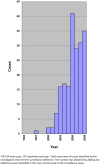An Epidemiologic Investigation of Potential Risk Factors for Nodding Syndrome in Kitgum District, Uganda
- PMID: 23823012
- PMCID: PMC3688914
- DOI: 10.1371/journal.pone.0066419
An Epidemiologic Investigation of Potential Risk Factors for Nodding Syndrome in Kitgum District, Uganda
Abstract
Introduction: Nodding Syndrome (NS), an unexplained illness characterized by spells of head bobbing, has been reported in Sudan and Tanzania, perhaps as early as 1962. Hypothesized causes include sorghum consumption, measles, and onchocerciasis infection. In 2009, a couple thousand cases were reportedly in Northern Uganda.
Methods: In December 2009, we identified cases in Kitgum District. The case definition included persons who were previously developmentally normal who had nodding. Cases, further defined as 5- to 15-years-old with an additional neurological deficit, were matched to village controls to assess risk factors and test biological specimens. Logistic regression models were used to evaluate associations.
Results: Surveillance identified 224 cases; most (95%) were 5-15-years-old (range = 2-27). Cases were reported in Uganda since 1997. The overall prevalence was 12 cases per 1,000 (range by parish = 0·6-46). The case-control investigation (n = 49 case/village control pairs) showed no association between NS and previously reported measles; sorghum was consumed by most subjects. Positive onchocerciasis serology [age-adjusted odds ratio (AOR1) = 14·4 (2·7, 78·3)], exposure to munitions [AOR1 = 13·9 (1·4, 135·3)], and consumption of crushed roots [AOR1 = 5·4 (1·3, 22·1)] were more likely in cases. Vitamin B6 deficiency was present in the majority of cases (84%) and controls (75%).
Conclusion: NS appears to be increasing in Uganda since 2000 with 2009 parish prevalence as high as 46 cases per 1,000 5- to 15-year old children. Our results found no supporting evidence for many proposed NS risk factors, revealed association with onchocerciasis, which for the first time was examined with serologic testing, and raised nutritional deficiencies and toxic exposures as possible etiologies.
Conflict of interest statement
Figures
References
-
- Aall-Jilek L (1965) Epilepsy in the Wapogoro Tribe in Tanganyika. Acta psychiatrica scandinavica 41: 57–86.
-
- van der Waals F, Goudsmit J, Gajdusek DC (1983) See-ee:Clinical characteristics of highly prevalent seizure disorders in the Gbawein and Wroughbarh Clan region of Grand Bassa County, Liberia. Neuroepidemiology 2: 35–44.
-
- Gerrits C (1983) A West African epilepsy focus. Lancet 1: 358. - PubMed
-
- Kaiser C, Benninger C, Asaba G, Mugisa C, Kabagambe G, et al. (2000) Clinical and electro-clinical classification of epileptic seizure in west Uganda. Bulletin de la Societe de pathologie exotique 93: 255–259. - PubMed
-
- Lacey M (2003) Nodding disease: mystery of southern Sudan. Lancet Neurol 2: 714. - PubMed
MeSH terms
LinkOut - more resources
Full Text Sources
Other Literature Sources
Miscellaneous


